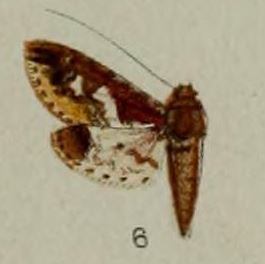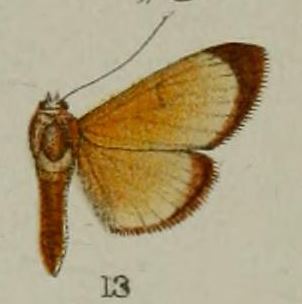
Logania watsoniana, or Watson's mottle, is a small but striking butterfly found in India that belongs to the lycaenids or blues. The species was first described by Lionel de Nicéville in 1898.
Scoparia deliniens is a moth in the family Crambidae. It was described by Thomas Pennington Lucas in 1898. It is found in Australia, where it has been recorded from Queensland.
Bocchoris pulverealis is a moth in the family Crambidae. It was described by George Hampson in 1898. It is found on Java.
Desmia odontoplaga is a moth in the family Crambidae described by George Hampson in 1898. It is found in Panama and Brazil.

Desmia chryseis is a moth in the family Crambidae. It was described by George Hampson in 1898. It is found in Venezuela and Peru.

Eurrhyparodes syllepidia is a moth in the family Crambidae. It was described by George Hampson in 1898. It is found in Mexico and Costa Rica.
Filodes xanthalis is a moth in the family Crambidae. It was described by George Hampson in 1898. It is found on New Guinea.
Pilocrocis calamistis is a moth in the family Crambidae. It was described by George Hampson in 1899. It is found in the Mexican state of Veracruz and Costa Rica.
Pycnarmon crocalis is a moth in the family Crambidae. It was described by George Hampson in 1899. It is found in Papua New Guinea, where it has been recorded from the D'Entrecasteaux Islands.
Syllepte mesoleucalis is a moth in the family Crambidae. It was described by George Hampson in 1898. It is endemic to South Africa.
Syllepte nasonalis is a moth in the family Crambidae. It was described by George Hampson in 1898. It is endemic to South Africa.
Syllepte ochrotozona is a moth in the family Crambidae. It was described by George Hampson in 1898. It is found in Australia, where it has been recorded from Queensland.
Syllepte orbiferalis is a moth in the family Crambidae. It was described by George Hampson in 1898. It is found on Réunion and in South Africa.

Syllepte solilucis is a moth in the family Crambidae. It was described by George Hampson in 1898. It is found in Western New Guinea, Indonesia.
Syllepte hyalescens is a moth in the family Crambidae. It was described by George Hampson in 1898. It is found in Nigeria.
Syllepte purpurascens is a moth in the family Crambidae. It was described by George Hampson in 1899. It is found in the Democratic Republic of the Congo, Kenya, South Africa and Tanzania.
Syllepte ochrifusalis is a moth in the family Crambidae. It was described by George Hampson in 1899. It is found in Papua New Guinea, where it has been recorded from the D'Entrecasteaux Islands.
Tyspanodes creaghi is a moth in the family Crambidae. It was described by George Hampson in 1898. It is found on Borneo and in Papua New Guinea and Australia, where it has been recorded from Queensland.

Auzata minuta is a moth in the family Drepanidae. It was described by John Henry Leech in 1898. It is found in the Chinese provinces of Hubei, Sichuan, Guizhou, Yunnan, Zhejiang and Shanxi.
Plectophila eucrines is a moth in the family Xyloryctidae. It was described by Turner in 1898. It is found in Australia, where it has been recorded from and New South Wales and Queensland.


